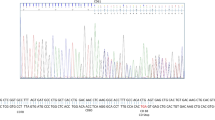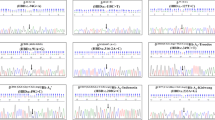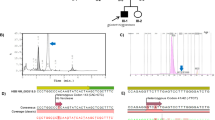Abstract
Hemoglobin Q- India (alpha) 64 Asp → His is an alpha chain variant which is generally found in heterozygous state and presents normal hematological blood picture. Here we report a rare case of HbQ-India with a thalassemic phenotype that has been analyzed using a combination of mass spectrometry, gene sequencing and PCR analysis. This combined analyses revealed the HbQ variant to be associated with a beta chain mutation, IVS 1-1 [G>T]. Though HbQ has earlier been reported with thalassemic trait using different techniques, this is the first report of a compound α and β chain Hb heterozygous mutant involving HbQ and IVS1-1 being validated using Mass Spectrometry and Reverse dot blot hybridization.
Similar content being viewed by others
References
Shackleton CHL, Falick AM, Green BN, Witkowska HE. Electrospray mass spectrometry in the clinical diagnosis of variant hemoglobins. J Chromatography B 1991; 562: 175–190.
Wada Y. Advanced analytical methods for hemoglobin variants. J Chromatography B 2002; 781: 291–301.
Wild BJ, Green BN, Cooper EK, Lalloz RA. Rapid identification of hemoglobin variants by electrospray ionization mass spectrometry. Blood Cells Mol Dis 2001; 27: 691–704.
Vella F, Wells RHC, Ager JAM, Lehmann H. A hemoglobinopathy involving hemoglobin H and a new(Q) hemoglobin. Br Med J 1958; 1: 752–725.
Sukumaran PK, Merchant SM, Desai MP. Hemoglobin Q India (alpha 64 (E13) aspartic acid to histidine) associated with betathalassemia observed in three Sindhi families. J Med Genet 1972; 9: 436–442.
Desai DV, Dhanani H, Kapoor AK, Yeluri SV. HbQ-India in a Sindhi family: an unknown hemoglobin variant. Lab Hematol 2004; 10: 212–214.
Mandal AK, Bisht S, Balaram P, Bhat VS, Krishnaswamy PR. Electrospray mass spectrometric characterization of hemoglobin Q (HbQ-India) and a double mutant hemoglobin S/D in clinical samples. Clin Biochem 2008; 41: 75–81.
Ching - Nan Ou, Rognerud CL. Rapid Analysis of Hemoglobin Variants by Cation-Exchange HPLC. Clin Chem 1993; 39/5: 820–824.
Lorkin PA, Charlesworth D, Lehmann H, Rahbar S, Tuchinda S, Lie-Injo LE. Two hemoglobin Q, alpha-74(EF3) and alpha-75 (EF4) aspartic acid to histidine. Br J Hematolol 1970; 19: 117–125.
Newton CR, Graham A, Heplinstall LE. Analysis of any point mutation in DNA. The amplification refractory mutation system (ARMS). Nucleic Acid Res 1989; 17: 2305–2316.
Desai D, Parmar C, Dhanani H, Patel R, Master D. A Rare case of Co-Existent HbQ India-Beta Thalassemia Trait. Int J Hematol 2007; 3: 1.
Author information
Authors and Affiliations
Corresponding author
Rights and permissions
About this article
Cite this article
Bhat, V.S., Dewan, K.K., Krishnaswamy, P.R. et al. Characterization of a hemoglobin variant: HbQ-India / IVS 1-1 [G>T]-β-thalassemia. Indian J Clin Biochem 25, 99–104 (2010). https://doi.org/10.1007/s12291-010-0020-3
Published:
Issue Date:
DOI: https://doi.org/10.1007/s12291-010-0020-3




